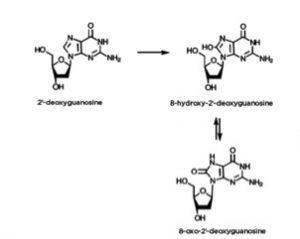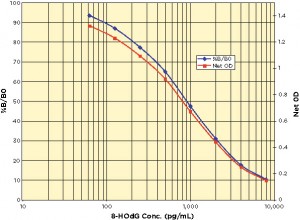Unique Kit for Detecting DNA Damage
Free radicals and other reactive species are constantly generated in vivo and cause oxidative damage to biomolecules. This process is held in check by the existence of multiple antioxidant and repair systems, as well as the replacement of damaged nucleic acids, proteins and lipids. Intracellular free radical species (ROS) are produced as a result of normal metabolism, and extracellular forms are produced by ultraviolet or ionizing radiation. Cellular function may be interrupted or stopped if DNA damage corrupts the integrity of essential information contained in the genome. When individual bases are damaged, nonspecific DNA repair enzymes excise DNA lesions to release deoxynucleotides, and base-specific repair glycosylases modify the corresponding base. Deoxynucleotides are enzymatically hydrolyzed to stable deoxynucleosides, and these repair products are transported through the blood and excreted in the urine. Damage to RNA is reflected in nucleoside adducts. It is widely thought that continuous oxidative damage to DNA is a significant contributor to the age-related development of major cancers such as colon, breast, rectum, and prostate. Among numerous types of oxidative DNA damage, the formation of 8-hydroxy-2’- deoxyguanosine (8-OHdG) is a ubiquitous marker of oxidative stress. 8-OHdG is physiologically formed and enhanced by chemical carcinogens. During the repair of damaged DNA in vivo by exonucleases, the resulting 8-OHdG is excreted without further metabolism into urine.
Arbor Assays’ DNA Damage EIA Kits detect the DNA and RNA markers of DNA Damage – detecting 8-hydroxy-guanosine (8HOG), 8-hydroxy-2’-deoxyguanosine, and 8-hydroxyguanine. These molecules are produced from DNA by ionizing radiation, such as radioactive decay or UV light, or reactive oxygen species interactions with biological systems. In the traditional assay method for DNA Damage, 8HOG is oxidized and conjugated to a protein such as BSA and immobilized on a plate. To address problems with reproducibility inherent in this method, Arbor Assays developed a unique new assay method that delivers exceptionally reproducible results.
The Arbor Assays DNA Damage EIA Kit features:
- Highly reproducible results in 2.5 hours
- Compatibility with a wide variety of sample types including serum, plasma, saliva, urine, digested DNA, fecal extracts and TCM
- Liquid reagents stable at 4°C
- Sensitivity to 51 pg/mL
RELATED PRODUCTS
Catalase Colorimetric Activity Kit, K033-H1
FRAP™ (Ferric Reducing Antioxidant Power) Detection Kit, K043-H1
Glutathione Colorimetric Detection Kit, K006-H1
Glutathione Fluorescent Detection Kits, K006-F
Glutathione Reductase Fluorescent Activity Kit,


